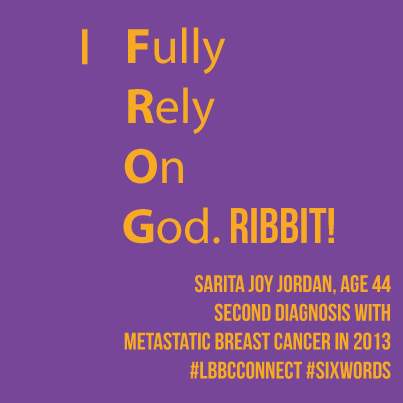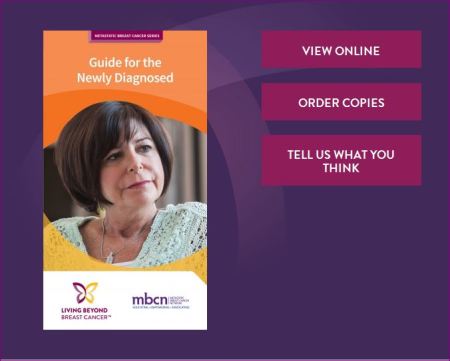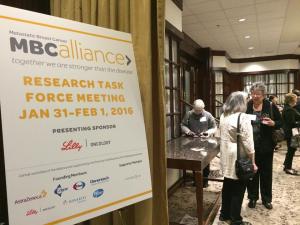
Laura and friend
Laura Snyder is a wife, mother of two, triathlete and patient advocate. In 2012, at age 49, she learned she had stage IIIa breast cancer that was ER-positive and HER2-positive.Chemo, surgery and radiation followed and she was deemed cancer-free. But nine months later, Laura felt a lump in her neck.
She learned the cancer had metastasized to her lungs, liver, and mediastinal and supraclavicular lymph nodes. Laura was treated with Taxotere, Herceptin, and Perjeta. After scans showed no evidence of disease (NED), she continued on Herceptin and Perjeta. Early in 2015, while doing flip turns in the pool during her regular swims, she felt mildly disoriented. She subsequently learned she had brain mets. Whole brain radiation followed as did Xeloda and Tykerb. In January 2016, additional lesions were found and she had gamma knife treatment. In June of 2016, after experiencing vertigo, Laura learned she had more brain mets and again had gamma knife treatment. She’s currently on TDM-1.
After Laura’s most recent gamma knife treatment, she drew a self-portrait of herself in “the cage” aka the head frame used to ensure a patient remains in the exact same position for the procedure. Her drawing was so powerful it prompted us to invite her to share her story–and like Laura, this story is multi-faceted. Brain mets is part of it but there is so much more. You can read more about Laura on her blog. –Katherine O’Brien, MBCN, July 2016
Before, During and After
By Laura Snyder
June 2016: Back in the Cage | Before: – the abject, jaw clenching dread. During – the “Breathe, just breathe, from the belly” I repeat to myself throughout the seven hours I’m in this cage, feeling like a torture victim right out of a sci-fi horror movie. After – I don’t remember, did we get Vietnamese food? As David Byrne sang, “Well, how did I get here?”
Let’s go back in time. . .
July 2012: Stage IIIa Diagnosis | In July I did my best Olympic distance triathlon to date. That’s a mile swim, a 25-mile bike ride, and a 10k (6.2 miles) run. I was a youthful 49 years old. This was me four years ago, thinking about whether to continue with this distance or move to a half Ironman.
Yup. One month later, I was diagnosed with Stage IIIa HER2+++ breast cancer in my right breast and several lymph nodes. Premeds are better now but the treatments have been the same for decades. Some of us call it Poison/Slash/Burn. First I had a six month regimen of difficult IV chemotherapy, followed by a bilateral mastectomy right to implants and axillary lymph dissection in which twenty of my precious lymph nodes were removed.
Pathology showed I did not have a pCR (pathologic complete response) to chemo, which I had been hoping for, and which I would have prayed for were I not a staunch atheist. Then the Burn – seven weeks of daily radiation an hour from home. I was done (except for the rest of the Herceptin infusions)! At least I thought/hoped I was.
May 2014: It’s Back | I suddenly felt a lump in my neck in May. It seemed to come out of nowhere. I tossed and turned with anxiety all night, and in the morning called my beloved oncologist. His response was “When can you get here?” Two hours later he was talking me down from a cliff and encouraging me to let the biopsy tell us what was going on.
Turns out I am one of the estimated 28% of early stage breast cancer survivors whose cancer metastasizes – mine to lymph nodes, liver, and lungs. After another regimen of chemo, this time for about eight months, I was pronounced NED (No Evidence of Disease). I prefer to call it NRED at this point of being a grizzled old cancer veteran, which stands for No Radiologic Evidence of Disease. Because with MBC YOU JUST NEVER KNOW.
June 2015: Brain MRI | In June, I felt just a little funny doing flip turns in the pool. In another life I would have chalked it up to hunger, or dehydration, but in mets life I bugged my doc for a brain MRI. Yup. Eighteen lesions in what’s called a miliary pattern (don’t ask, I still don’t get it!), which meant they could not be treated with gamma knife so ten rounds of whole brain radiation later I was sent home to wait and see what my next scans would show. And I had to drop my beloved Herceptin and Perjeta and switch to Xeloda and Tykerb which are thought to cross the blood brain barrier.
January 2016: Shocking Developments | January: I was shocked – I don’t know why – to find out there were four lesions in my brain. Gamma knife here we go.
This involves wearing a cage literally screwed into the head, two in the forehead and two in the back of the head. It’s not lightweight by any stretch either. Each lesion would take about twenty minutes so I was in the game, after waiting hours for the detailed MRI to be read and for the radiation oncologist and medical physicist to plan their attack. Afterwards at a Vietnamese restaurant I was horrified to notice there was blood dripping down the back of my head.
June 2016: Vertigo | I’d had one clean brain MRI in April. Six weeks later I experienced some awful vertigo and asked to have the next one early. Lo and behold, a few more lesions to zap. Unfortunately, the more detailed MRI (1mm slices v. 5mm slices) showed 22. Yep, 22. I thought well, that’s it, I’m dead.
But the team wanted to gamma knife them all. I picture Dr. Kee, Dr. Adler, and the physicist whose name escapes me engaging in a huddle, coming out, doing a big chest bump, and hiking the ball. They were rock stars, as were the nurses and even an aromatherapy lady spritzing me with lavender and telling me to breathe as they bolted the frame on.
I was loopy (Ativan and Oxycodone), most of the time but I sensed that there was always some combination of this group around me, making sure I was doing OK. I wasn’t (who would?), but as we like to say at my house, it was “good enough for who it’s for.” I spent seven hours in the cage this time.
Treatment was again switched to TDM-1, part chemotherapy and part targeted treatment. And here I am. I am still reeling a little, and worried.

“Self Portrait With Cage” by Laura Snyder
Drawing My Feelings | I drew this picture (the first I have drawn since high school art class) as an outlet for how I felt/feel. Most people are lucky enough not to see an image like this in their lifetimes!
While drawing, I referred to a photo of me resting in denial of the cage around me. My drawing expresses the angst, sadness, and pain of finding oneself in this unenviable position. I’m no artist so I feel silly saying this, but I’m inspired by Frida Kahlo’s self portraits depicting the intense pain she suffered.
I call it “Self-Portrait with Cage,” stating the obvious. I couldn’t stop thinking “the devil’s in the details” when I looked at it. I think it’s because I drew very literally – the different colors of metal, the bolts and screws, the creases in the pillow and folds in the blanket, the dark circles under my tired, gray-tinged eyelids. I am planning to draw a series where I try to capture the emotions around MBC and its treatments.
How I Feel Now | In spite of this depressing report detailing the last four years, I find myself pretty content if I look through the lens of the everyday. I am a dedicated yoga practitioner and this I think has helped my body and mind more than anything. I don’t work, because each time I’ve tried some cancer catastrophe is thrown my way to deal with (see all of above!).
I swim; knit; write (not enough); play ukelele; hang out with my husband, kids (18 and 20 years old), and friends; and of course have started to draw. I started a yoga for cancer class at my local hospital, taught by my fabulous and inspired teacher, a yoga therapist. I’ve attended two LBBC Metastatic Breast Cancer Conferences and made deep friendships that started online even deeper. And learned how to be an advocate in LBBC’s Hear My Voice Program and lots of other stuff too.
Summing Up | I’m still alive to say that if you have MBC I have some advice:
- Support groups, whether online or in person, are invaluable. We can be so isolated and scared without other people to communicate with who walk in our shoes.
- And… be careful about getting your information from legitimate web sites or oncology professionals. There are a lot of ridiculous scams and “cures” to be found. Go the science direction.
- Find a yoga class that suits you and exercise when you can.
- AND find some contentment in your life every day. Your life is not over yet!!





 Posted by MBCNbuzz
Posted by MBCNbuzz 




 MBCN has popularized the phrase “Scan, Treat, Repeat: Stage IV Needs More.” Ginny and I were talking about a motto that could be used to along with MBCN’s new logo and that is what we came up with. Ginny created the first iteration–complete with the now familiar circle and three arrows. I have seen doctors use the Scan Treat Repeat logo in their metastatic breast cancer presentations and patients quickly embraced it, too. Anyone would be proud to contribute a phrase to general usage, but Ginny has the distinction of contributing the saying as well as boosting people’s understanding of the disease. MBC advocates often talk about “changing the breast cancer conversation.” Ginny has well and truly has done that.
MBCN has popularized the phrase “Scan, Treat, Repeat: Stage IV Needs More.” Ginny and I were talking about a motto that could be used to along with MBCN’s new logo and that is what we came up with. Ginny created the first iteration–complete with the now familiar circle and three arrows. I have seen doctors use the Scan Treat Repeat logo in their metastatic breast cancer presentations and patients quickly embraced it, too. Anyone would be proud to contribute a phrase to general usage, but Ginny has the distinction of contributing the saying as well as boosting people’s understanding of the disease. MBC advocates often talk about “changing the breast cancer conversation.” Ginny has well and truly has done that.



 On Facebook, she was
On Facebook, she was  Her faith never wavered. Adrian was often exhausted from her treatments but few people who saw her would have guessed this. “There are many things in life that happen that we don’t plan, but we adjust, regroup and keep pushing forward,” she said. “No matter what, I refuse to lose. I am tired every day, but it is my duty to fight like a big girl. All the challenges I face, I do it with a smile. I have a family that needs me, but loves me more.”
Her faith never wavered. Adrian was often exhausted from her treatments but few people who saw her would have guessed this. “There are many things in life that happen that we don’t plan, but we adjust, regroup and keep pushing forward,” she said. “No matter what, I refuse to lose. I am tired every day, but it is my duty to fight like a big girl. All the challenges I face, I do it with a smile. I have a family that needs me, but loves me more.”








